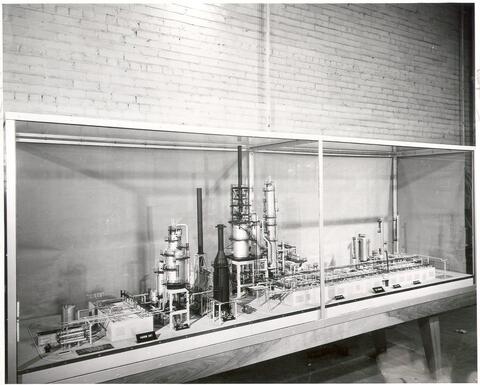
Zone du titre et de la mention de responsabilité
Titre propre
Petroleum Engineering - "Cat Cracker" Model
Dénomination générale des documents
- Document graphique
Titre parallèle
Compléments du titre
Mentions de responsabilité du titre
Notes du titre
Niveau de description
Pièce
Cote
Zone de l'édition
Mention d'édition
Mentions de responsabilité relatives à l'édition
Zone des précisions relatives à la catégorie de documents
Mention d'échelle (cartographique)
Mention de projection (cartographique)
Mention des coordonnées (cartographiques)
Mention d'échelle (architecturale)
Juridiction responsable et dénomination (philatélique)
Zone des dates de production
Date(s)
-
1955 (Production)
Zone de description matérielle
Description matérielle
1 photograph : b&w ; 20 x 24 cm
Zone de la collection
Titre propre de la collection
Titres parallèles de la collection
Compléments du titre de la collection
Mention de responsabilité relative à la collection
Numérotation à l'intérieur de la collection
Note sur la collection
Zone de la description archivistique
Nom du producteur
Historique de la conservation
Portée et contenu
Image of a cat-cracker-model relating to Petroleum Engineering.
Zone des notes
État de conservation
Source immédiate d'acquisition
Classement
Langue des documents
Écriture des documents
Localisation des originaux
Disponibilité d'autres formats
Restrictions d'accès
Délais d'utilisation, de reproduction et de publication
Photographer: Saskatoon Star-Phoenix
Copyright: Saskatoon Star-Phoenix
Instruments de recherche
Éléments associés
Accruals
Note générale
From Star-Phoenix article on back of image: "Petroleum Engineering - a new branch in the College of Engineering - is being introduced at the University of Saskatchewan for the 1955-1956 term. The new branch will take its place along with the other seven branches of engineering: agricultural, chemical, civil, electrical, geological, mechanical and engineering physics. The university's first appointment in the branch is assistant professor R.B. Shearn, a graduate of the University of Birmingham. The course is designed for the student intending to engage in the engineering phases of the production of oil and gas, rather than the exploration and geological work to do with the searching and development of oil and gas fields. Students who have satisfactorily completed the third year in chemical engineering or geological engineering will be admitted to a final fourth year in petroleum engineering. Because of the differences in the first three years of training, part of the work will differ for the two groups. Both will, on graduation, have a similar amount of engineering training, but one will have a broader knowledge of chemistry and the other of geology. Either is quite satisfactory for this field of engineering and allows for later specilization, if desired. Imperial Oil Ltd. presented a model of a modern oil refinery to the engineering college in November. The model is of the latest fluid catalytic cracking unit and vacuum distillation unit of the Regina plant. The model is built on a scale of 1/4 inch to the foot. It measures six feet by twwn feet and is approximately four feet high. These units formed the magjor part of an expansion program which was two years in the building and cost more than $7 million. The model is valued at $5,000. The model travelled to Saskatoon in a special moving van on a six-inch thickness of felt padding. On top of this were inflated rubber tubes, covered by a 700 pound sheet of boiler plate. On top of it were more pads and a huge sheet of sponge rubber. The model sat on a wooden frame and was held down by robes attached to large coil springs. Old tires were placed between the walls of the van and the model. These precautions were necessary to prevent the vibration from shaking the balsa wood and plastic to pieces. The high towers of the model were braced with wood, heavy cord and adhesive tape. The model is not a show piece but for practical demonstration purposes in the college."

